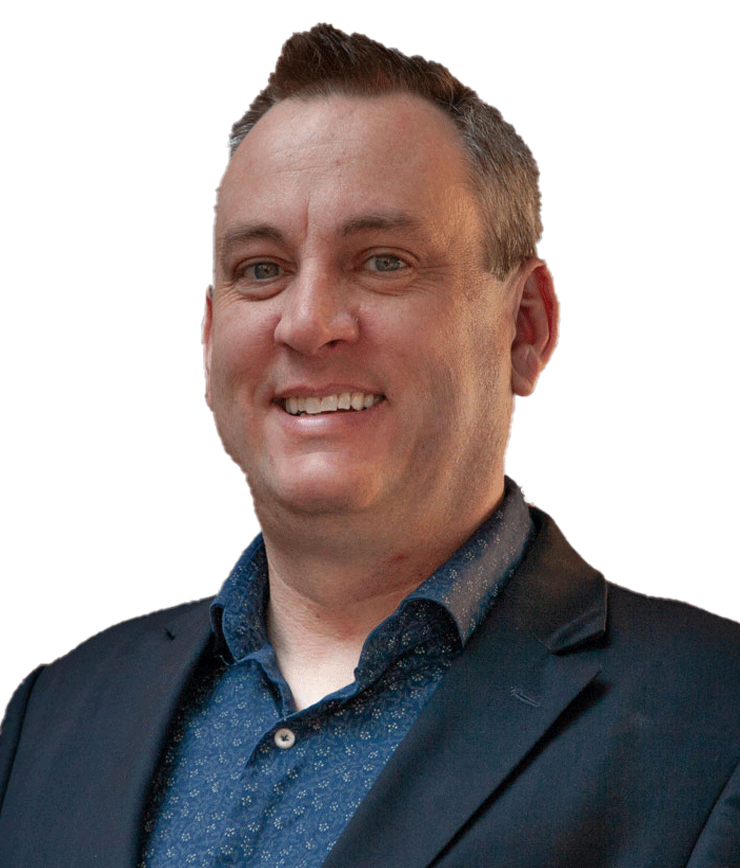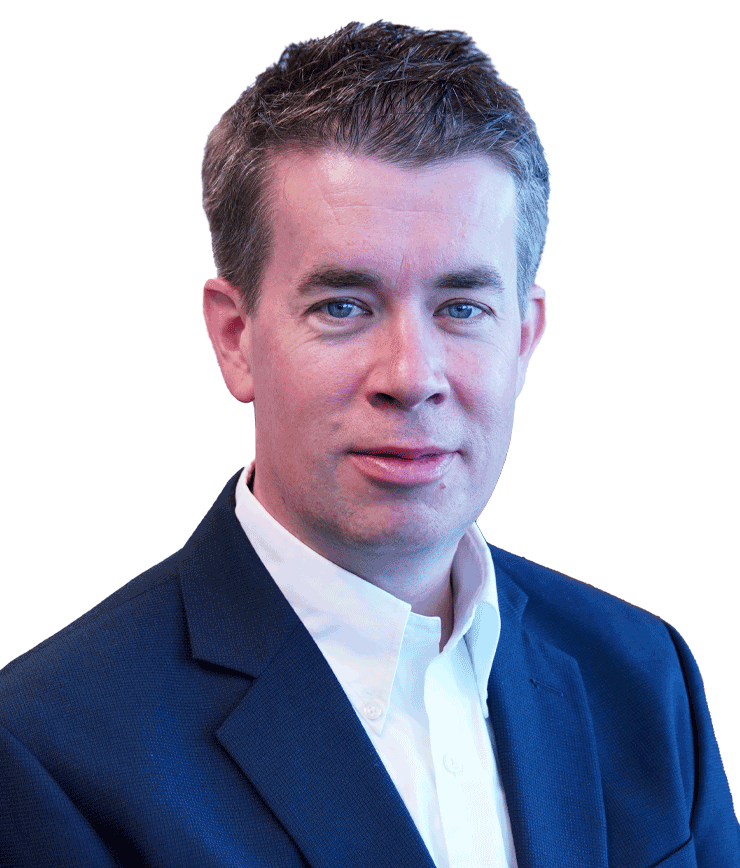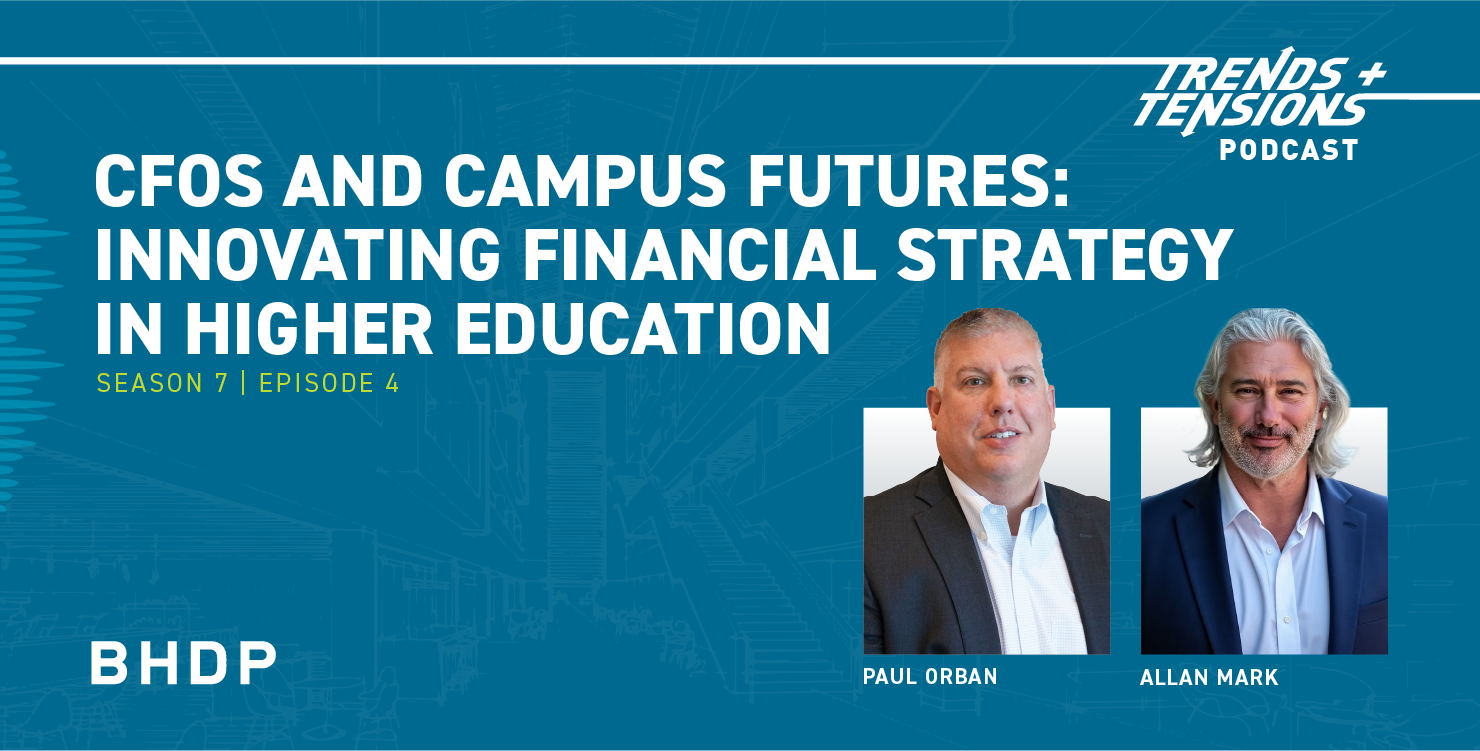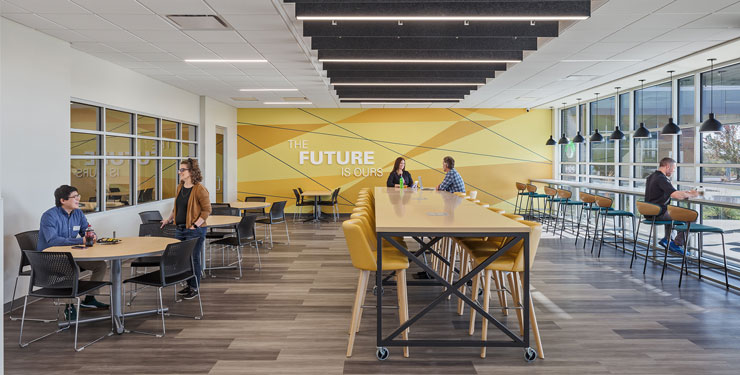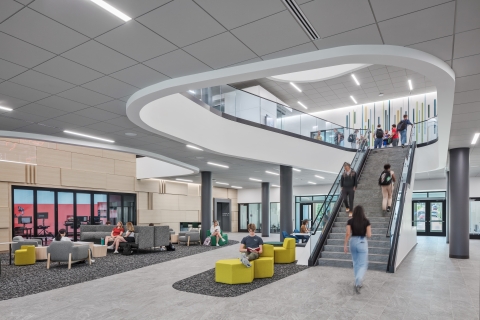
Higher Ed, Redefined: Meeting the Needs of Modern Learners
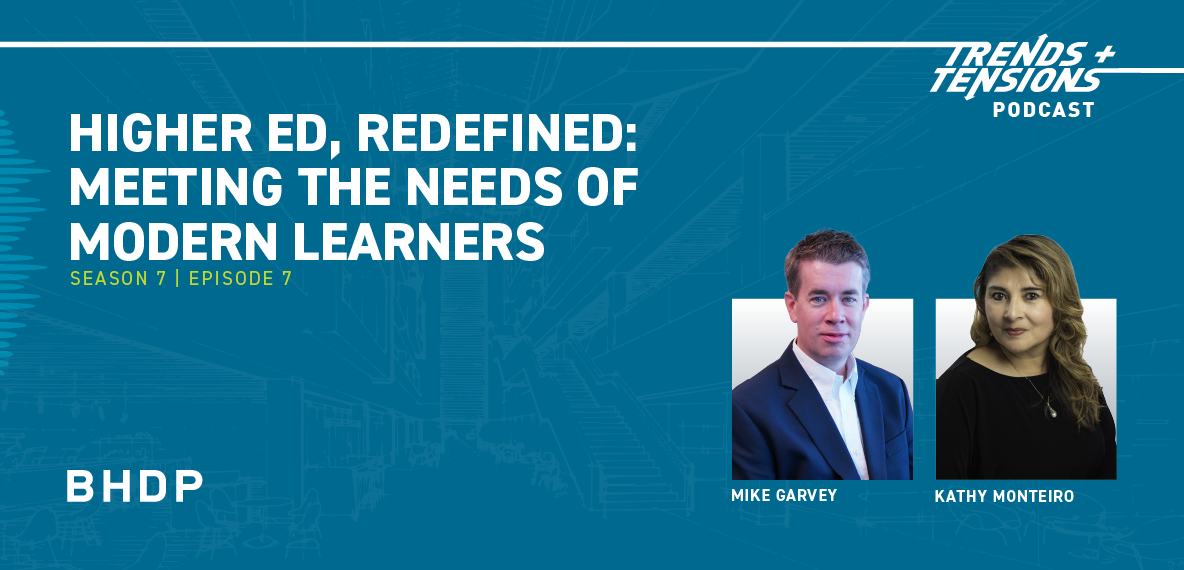
Want to listen on another platform? Choose your platform here.
Episode Transcript
[Music Intro]
Brian Trainer, Host: Welcome to Trends + Tensions in Architecture and Design, presented by BHDP, where we discuss Trends in Architectural and Interior design and the competing priorities or Tensions that arise from integrating new ideas into existing organizations, enterprises, and institutions. In this episode, “Higher Ed, Redefined: Meeting the Needs of Modern Learners,” we are joined by Kathy Monteiro, Director of Design & Construction at Wake Tech Community College, along with Mike Garvey, Client Leader at BHDP. I am your host, Brian Trainer, senior strategist for BHDP. Let’s get started!
Brian: So today we're gonna talk about changes in student populations and how universities and institutions are adapting. We have a couple guests with us today. I wanna start with Kathy. Kathy, tell us who you are and what you do.
Kathy Monteiro: Hello Brian. I'm Kathy Monteiro. I am the Director for Design and Construction here at Wake Tech Community College. I am an architect by profession. I'm originally from New Jersey with over 27 years of higher education, still doing design and construction. I've done work for public and private institutions, and I joined Wake Tech five years ago.
Brian: Great. Kathy, welcome to the program. Mike, tell people who you are and what you do.
Mike Garvey: Thank you, Brian. It's a pleasure to be here today and thank you, Kathy for being here with me. My name is Mike Garvey and I am a client leader for the Higher Education Studio with BHDP Architecture. I work in our southeast region, and again, my focus is on colleges and universities. I’ve been with the company for about three years, I've been in architecture for about 20 years. I'm looking forward to our conversation today.
Brian: I'm gonna kick it back to you here in just a second because as I alluded to at the beginning, we're talking about changes in student population. You've been doing research in that area. What can you share that you've discovered so far?
Mike: Sure, certainly. Thanks Brian. So the genesis of this really is, aside from architecture, BHDP does a lot of work in the area of research and thought leadership. There's a topic that has come up quite a bit in recent years about the rise of the non-traditional, if we can use that term loosely, of student population and the effect that those students are having on campuses, the unique needs, opportunities, and demands that they present to two year and four year institutions and the sort of critical nature of that population when it comes to institutions planning their future.
So, I'm working on a longer research project this year around that topic. But where we are now is part of the genesis of this article that was published in the Manhattan Institute back in January of this year, this was an article written by Terrell Dunn. The article title is “When the Exception Becomes the Norm: The Rise of Non-Traditional Students in Higher Education”. And there's a lot in here that's interesting and we've done a lot of other reading and research around this topic, but one particular quote jumped out at me. This is from a gentleman named Jon Boeckenstedt writing in the Chronicle of Higher Education, that this article then references, where he said: “the basis of most of our foresight comes from federal data and from data produced by the Western Interstate Commission for Higher Education. Both data sets generally show the same thing. The number of public high school graduates is expected to peak in 2025 or 2026 and then fall off. The commission says three and a half million in 2025. Federal data says no more than 3.4 million in 2026. Then both data sets agree. We're going to see a steady decline as far out as the projections go.” So with that, I might almost say romanticized idea of the classic 18 to 21-year-old high school graduate coming into our institutions and universities falling as the birth rate in the United States falls as well. The group of what we might call non-traditional students is gonna become ever more important for the college campuses as they seek to hit enrollment goals. And so understanding that population, figuring out how our campuses and our programs need to respond to them is going to become a very crucial enterprise for most colleges and universities.
Brian: So that's interesting. You were talking about birth rates being tied to, that makes sense because if there's fewer people, there's fewer graduates, fewer are going to colleges. But what's changed in the population though, because I, myself. I'm interested in this because I'm a non-traditional student. I was 11 years older than most of the people in my architectural class when I went back. What have the changes been in the population?
Mike: So the data that we're gathering through this research so far shows that currently, as many as perhaps 40% of higher education students identify as we might say, non-white when it comes to race demographic. Data is showing that approaching a third of them, have a primary language, this is within the United States, that is other than English. A third of them are 25 years old or older, 20% of students in higher education today have dependent children, and nearly 45% of them, by some data measures, are financially independent from their parents.
Those are striking metrics, if you will. That challenge, as I said a moment ago, that romanticized idea of the sort of classic 18 to 21-year-old student coming straight out of high school and going into higher education. And one last data point I'll share that I think emphasizes what I was talking about from the Chronicle of Higher Education writer outside of maybe the top 100 institutions in the United States over the next few years, all of the other institutions anticipate a decline of more than 10% in that traditional, again, directly out of high school young, classic student population.
Brian: So that's interesting information to have in your back pocket. I'm curious, Kathy. What you've seen at Wake Tech after hearing Mike's data, I know we were looking at it beforehand, but have you seen any correlation with what's going on at Wake Tech?
Kathy: Actually I do see some trendsetting that in our case, because we are a community college, is more of an increase in student population, and I do agree with Mike's projections. The non-traditional students, they are at least 25 years or older. Some have not graduated from your traditional high school, but they have GEDs, some work at least part-time, they have family responsibilities some are single parents, and some maybe just wait a few years or they're the first, and that's the main thing at Wake Tech is some of our students are their first in their family to ever attend college, and they could be at 18/19, or beyond 25 years of age. So in our case, we are a vocational, we started as a vocational and technical college that has emerged so immensely right now that we have seven campuses.
Brian: Do you want to give us a little history of Wake Tech?
Kathy: Wake Tech began as an educational center to train adults for the emerging industries at the time, and that was in the 1950s. It was agriculture. Mainly agriculture and healthcare. It was chartered in 1958 as Wake County Industrial Education Center and it at that point they also launched the licensed Practical Nursing Program for what today is Wake Med. The name then changed again in ‘65 to Holding Technical Institute, renamed in 1974 to Wake Technical Institute. And then we come to 1980. Where it was called Wake Technical College. Finally, it's 1987 now. We've maintained our name, Wake Technical Community College. So from one building, and then the South campus, which is the main campus. It has grown to seven campuses and we cover all of Wake County. So Wake Tech is one of the largest community colleges in the eastern coast. We have over 72,000 students. As far as Mike, when you said that their language is non-English? That is correct. I did a little bit of research and we have about 137 native countries of Wake Tech students.
Brian: Wow.
Kathy: Yeah. Yeah. 137.
Brian: So it sounds like you've been positioned to serve a non-traditional student population since the very beginning. And I'm wondering, so having that kind of longitudinal expertise, what are unique needs of non-traditional students?
Kathy: It's funny that you ask that question 'cause you would tend to say, all non-traditional students, every student is different. But when you try to assess and not go through the outliers, what they need as a young adult to a middle age adult, and who knows even in my sixties, if I wanna change my career path, is flexibility, more important, flexibility with your classes and resources, because as I just said, we have students that are non-English speaking, so some of them we even have to include English as a second language or another program that they call it: English as a Foreign Language for those that are professional adults who require a different level of English grammar and industrial or professional type of communication. But I feel that the unique needs are, even working with the computer. Even learning how to adapt and working with technology, because right now we don't teach as a lecture hall where the student will sit and listen to the teacher.
Some of the classes are done where it's a conference room, where you're expected to make decisions at the table. So being confident, believing in yourself and trying to find a path for the student to be successful is what drives Wake Tech’s faculty and staff. I really do. It's not just your book learning and taking your test, we are very hands-on, we are very hands-on. And the only classes that would require hands-on experience would be, as an example, the nursing and dental hygiene. But we do offer a lot of online classes.
Mike: I was gonna say, I'm sorry I was gonna jump in because what Kathy is saying here I think is on the right, I think they're on the right track at Wake Tech to respond to what we see as the trends in the needs for these students. As part of this research, we have been running a survey online for students sort of coast to coast through a service that we have.
And it's not done yet, but we've gotten around 150 or so responses. And these are people anonymous, but they self-identify as non-traditional students and the data pretty well bears that out. A lot of them say that their birth range is in the 1990s, a lot of them say that they're seeking their first degree, but they're financially independent, some of those other metrics I mentioned before. And I would say the three things out of the data from this group of 150 responses or so we've had so far that we see dramatically rising consistently to the top are that they want one, access to online classes. That matters more to them than anything else, opportunity for online learning. Wake Tech is very responsive to that. I think Kathy and I have talked in the past. I believe you guys are ranked as one of the largest online institutions in the world in terms of your population.
Kathy: Yes, we are.
Mike: Exactly. And that's an awesome accolade. And so you're well positioned to reach the specific population. The second thing we see rising to the top is a demand for courses, if it's an in-person course that is offered off hours. Weekend classes, night classes, holiday break classes, things along those lines. They're looking for times to be able to get in their credit courses that don't conflict with work and family schedules. And so that's another strong demand.
And then to close on what you were talking about a moment ago, Kathy, the other large data point we see coming out of this survey so far is more important to them than say, parking or dining or social spaces, things like that; is students' success. They want support in all of these things: English as a second language, tutoring options, writing centers. They have unique needs, some of which Kathy just went through, I won't retread that. But all the kinds of things that you intersect with a student when they're coming at college from a different angle and provide them that sort of student success support capacity, a location on campus where they can go, that they get that kind of support. In our work, as we are doing quite often, library design and things along those lines we're co-locating those facilities in what we come to call a knowledge commons, and that's where a student can come. It's different than a student union, it's a space they can come to if they've gotta do research, if they've gotta study.
That's the library aspect of it, but then they can also, under the same roof, get some of those critical student support, student success reinforcing resources that they need as well.
Kathy: No, you hit it. You hit it right Mike. Because we do have a student success center, but we also have a student care center. There are times that students will lose their job. They can't even afford breakfast. So we do offer food, we offer financial support in terms of being more therapeutic let's say. This is something different than your student counseling. This is different than your advisor for your classes. It's more on the emotional side, and we opened a student care center on North campus a year and a half ago. So they've had a small office, but it's actually growing. So this renovation made it twice as big right now, and people donate food the same way that you donate for Thanksgiving or your special holidays. Students themselves and even faculty and staff, they donate to the care center so that there's always something available for a student in need.
Brian: I'm curious too. Normally we focus on design aspects, but I wonder from a human resources perspective, have there been new positions within the campus created to support a diverse student population?
Kathy: There is, and they actually call them success coaches.
Brian: Interesting.
Kathy: Yes, they're called success coaches. The only reason why, is we do, when we're working on our designs and capital projects and renovations, we work extensively with our stakeholders and we get to learn more about what they do and more about what their programs are. And it was very interesting to learn terminology as opposed to saying, oh, let me go to my advisor so he can, or she can check my schedule, or I can't take this class, or I find it too hard. These success coaches are more to create a student to be a well-rounded person. Not just on your educational side, but also on your health side because if I feel, and I have children, they're actually grown. But if you're not thinking positively, if you are stressed in life, you're not going to feel confident in yourself. You're not gonna believe in yourself. And these success coaches, they do that for their students to make them feel comfortable and confident in their wellbeing that'll actually make them be successful. Not just feel successful, but be successful with the understanding there’s ups and downs in life. But never to give up.
Brian: I love that. I'm curious too because, so we do look at things from a building perspective and people occupy those buildings, so that's a very important component. But I wonder too about with this change, with a larger, non-traditional student population, with these diverse needs, how is that impacting campus planning? Are we thinking about college campuses differently than we did before?
Kathy: Don't forget we're a two year institution, but I will say this. Coming from four years in, four year institutions, colleges and universities from New Jersey, Northern region, and I came down here to Wake Tech and the quality of their design and construction is up to par with the four year institutions. I was, I was astonished. I was very surprised. And it, it brought a smile to my face. Cause normally, traditionally I would see community colleges with the most bulkiest of furniture, look like uncomfortable and I don't wanna sit here. And why bother coming here? It is inviting, it is engaging and welcoming. So to answer your question, what we've done is, we create study spaces, small, medium, large, and you can see that in the newest of the campus at Wendell is our East Wake site, our east campus.
We are trying to create, not just study a study hall, but little niches of rooms with technology, with a display so that the study groups, the students can work in teams or there might be someone that wants to study alone but be part of the room where everyone else is studying. So we do design, we have very good designers. You guys are part of that, that try and provide.
Mike: Thank you. Thank you for that, Kathy. I appreciate that.
Kathy: No. We do have, it's not just what the owner wants, but the expectation is to have a give and take and a form of partnership with our designers, and I believe it strongly that if there is no relationship building or if there isn't any coming and going with our designers, I don't want the designers just to say, Hey, the owner told me to do this. It is a partnership. It is a commitment, and it's a commitment to the students. And I do hope that the students realize that, and I think they do because you see an empty building and then finally you see once it's completed how everyone is using it. They're asking for more. Why can't the north campus have this? So little by little we're trying to generate these little niches. There's these little spaces. Now I can say also that coming from another college, a four year institution up north we had a commuter room because again, there were the adult students that would come into class.
They wouldn't know where to hang their hat. They need a printer. They need to print their essay or submit it. This is before actually having Zoom or having Teams or any of that, that we had established what we called a commuter lounge. It had the sofas, it would've had little tables and chairs. They had the printer, some computers. So you try to make it, you try to make the resources as available as possible so that there is that connection for the student to continue their studies and saying, Hey, you know what? They care about me. Let me be responsible enough and accountable, to proceed and do well in my studies. So that's what I've seen. I've seen that there in the four year institution and I do see that here at Wake Tech.
Brian: Thank you, Kathy. So we've got just a couple minutes left and I appreciate all the input I've received from both of you. I didn't know, Mike, did you have any other insight on how institutions are not future proofing, but future prepping for changes in student population.
Mike: I was at a conference not long ago that represents a number of private institutions that call the Appalachian Region home. And I was speaking with a vice president for Student Affairs at one of those institutions. I promised that I would keep all of these folks anonymous. But they were very, very gracious in sharing their opinions on this topic with them. And this person said, when it comes to non-traditional students, they have a life, they have a goal. So, in some cases, their approach to college is very transactional, as opposed to the romanticized view that we might have, whether it's fabricated or not, of the college experience.
To that end, I don't think we, as an industry, as two and four year institutions, have been intentional enough to date in terms of non-traditional students and having larger conversations around the unique needs they have, whether it's family, whether it's employment, whether it's food security, whether it's transportation. The conversation has been more focused around online learning, period. We need to broaden that conversation to these other unique needs that these students are presenting to our campuses and determine how best to meet those beyond just offering online classes.
Brian: Kathy, would you like to react to that at all? Any final thoughts you'd like to share before we go?
Kathy: Before we end, I do wanna say thank you for having me. It's been a pleasure listening to Mike and trying to address some of these questions. In what Mike just said, I do agree that the non-traditional student I believe that in their search to becoming their dream they are more forward in being decisive and where they feel their life is going to take them. When you're 18, 19, you are just learning the basics English literature, grammar, math comprehension, and all of that to get you started in your college setting. Some apply and their major is undecided, whereas the non-traditional student, they already probably had a career path and they're changing in order to meet the changing needs of the times, the changing industry, changing manufacturing, the changing profession, and that's what I think Wake Tech does very well. We do have a model of online learning. We do help the adult high school with, having their school diploma. We do have non-degree programs and yeah, the challenge has to do with difficulty with technologies because some non-traditional students, they may need additional support in using technology like I said before, for online learning, older students like myself, they're probably not used to doing a Zoom.
Doing virtual, it is, it takes time to learn and try to adjust and press the button to raise your hand if you're in a virtual classroom. So it's not just knowing the topic of the class, but trying to use the technology to help that student communicate through that virtual class, so it's overall encompassing to have all of these things done for a student where for perhaps a younger model, younger student who's used to the phone, used to technology, used to playing games, it'll come second natured while for others it'll take time to learn. But I really appreciate the time and this has been very informative to know the research that Mike has done. Mike, thank you so much as well, and this has been an exciting part of my day today.
Mike: I can't thank you enough for giving us your time and your insight. I always enjoy our conversations and the fact that this one gets to be recorded as a podcast, I think is so much the better.
But your perspective on things is always spot on. I've enjoyed this time with you. Thank you for being here with us.
Kathy: Thank you.
Brian: Thank you both very much and I hope you enjoy the rest of your day.
Kathy: Thank you, Brian. Thank you.
[Music Outro]
Brian Trainer, Host: Thank you for joining Trends + Tensions in Architecture and Design, presented by BHDP, for this episode, “Higher Ed, Redefined: Meeting the Needs of Modern Learners,” with Kathy Monteiro of Wake Tech Community College and Mike Garvey of BHDP. If you appreciate what you have heard, please rate, subscribe, and give us a review. I am Brian Trainer, your host, and I hope you’ll join us for another episode of Trends + Tensions to see what topics drive design.
Author
Content Type
Podcast
Date
July 11, 2025
Market
Practice
Topic
Hybrid Learning
Innovation

